
Ellora Caves are a multi-religious rock-cut cave complex with inscriptions dating from the period 6th century CE onwards, located in the Aurangabad District of Maharashtra, India. They are also called verul caves.

Jagannatha is a deity worshipped in regional Hindu traditions in India and Bangladesh as part of a triad along with his brother Balabhadra, and sister, Subhadra. Jagannath, within Odia Hinduism, is the supreme god, Purushottama, and the Para Brahman. To most Vaishnava Hindus, particularly the Krishnaites, Jagannath is an abstract representation of Krishna, or Vishnu, sometimes as the avatar of Krishna or Vishnu. To some Shaiva and Shakta Hindus, he is a symmetry-filled tantric form of Bhairava, a fierce manifestation of Shiva associated with annihilation.
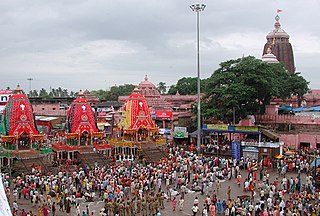
The Ratha Yatraof Puri, also rendered as the Ratha Jatra, is considered the oldest and largest Hindu chariot festival celebrated annually, on the bright half of the lunar month of Ashadh (June–July). The festival is held at the city of Puri, in the state of Odisha, India and associated with the deity Jagannath. During the festival, three deities are drawn by a multitude of devotees in three massive, wooden chariots on bada danda to Gundicha Temple whereby they reside there for a week and then return to the Jagnannath temple.

Puri is a coastal city and a municipality in the state of Odisha in eastern India. It is the district headquarters of Puri district and is situated on the Bay of Bengal, 60 kilometres (37 mi) south of the state capital of Bhubaneswar. It is also known as Sri Jagannatha Dhama after the 12th-century Jagannath Temple located in the city. It is one of the original Char Dham pilgrimage sites for Hindus.
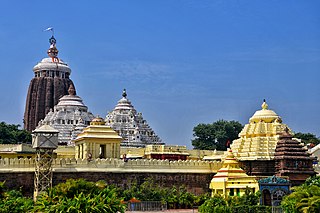
The Jagannath Temple is an important Hindu temple dedicated to Jagannath, a form of Vishnu – one of the trinity of supreme divinity in Hinduism. Puri is in the state of Odisha, on the eastern coast of India. King Indradyumna of Avanti has built the main temple of Jagannath at Puri. The present temple was rebuilt from the tenth 10th century onwards, on the site of pre-existing temples in the compound but not the main Jagannatha temple, and begun by Anantavarman Chodaganga, the first king of the Eastern Ganga dynasty. many rumours are spread about the temple but there is no solid proof of it. The temple is one of the 108 Abhimana Kshethram of Vaishnavate tradition.

A mandapa or mantapa is a pillared hall or pavilion for public rituals in Indian architecture, especially featured in Hindu temple architecture.

Konark Sun Temple is a 13th-century CE Sun temple at Konark about 35 kilometres (22 mi) northeast from Puri city on the coastline in Puri district, Odisha, India. The temple is attributed to king Narasimhadeva I of the Eastern Ganga dynasty about 1250 CE.

Gundicha Temple, is a Hindu temple, situated in the temple town of Puri in the state of Odisha, India. It is significant for being the destination of the celebrated annual Rath Yatra of Puri. While it remains vacant most of the year, the temple is occupied by images of the deities of Jagannath, his brother Balabhadra and sister Subhadra for seven complete days every year during the annual Rath Yatra festival.

The Char Dham, also rendered the Chatur Dhama is a set of four pilgrimage sites in India. Since the establishment of the Char Dham temples, visiting these sites has become a path to achieve moksha. The four Dhams are Badrinath, Dwarka, Jagannath and Rameswaram.

Baladevjew Temple is situated in Ichhapur, Kendrapara, Odisha, India. Baladevjew Temple is a very famous temple of Odisha and Balarama is its main divinity. However, Jagannath and Subhadra are also worshipped in the Ratna Sinhasan in the main temple. An idol representing tulasi as a goddess in a seated position is also present after the sacred seven steps.
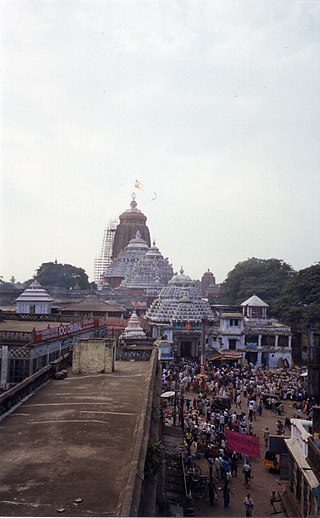
Nilachala, also rendered Niladri refers to a region corresponding to Puri, in the Indian state of Odisha.
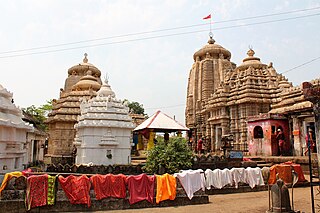
The Kapilesvara temple is a Hindu temple dedicated to Shiva located in the south western outskirt of the village Kapilesvara, Old Town, Bhubaneswar, Odisha, India. It is located at the end of Kapilesvara road leading from Lingaraj temple to Kapilesvara Village. The presiding deity is a Siva-lingam at the center of a circular yonipitha inside the sanctum. It is a living temple, facing towards east and maintained by Kapilesvara Temple Trust Board. The temple is situated within the precinct along with 33 other monuments. The precinct is located on the northern embankment of Manikarnika tank over an area of 44.00 square metres.
This mandapa is located within the Gosagaresvara siva temple precinct, Old Town, Bhubaneswar. It is a lofty platform (mandapa) provided with a flight of steps. There are sixteen pillars that support the superstructure of the flat roof. Construction of a mandapa within a precinct is a feature of Orissan temple ritual and architecture. These mandapas usually have sixteen pillars which are also noticed in the Hazari Mandapa in Kapilesvara temple precinct, Jalesvara Mandapa in the Jalesvara temple precinct of Kalarahanga, and MuktiMandapa in the Jagannatha temple precinct of Puri.

Shri Shri Hari Baladev Jew Bije is a famous Hindu temple located in Baripada, Mayurbhanj district, in the state of Odisha, India. The name Jagannath is a combination of the Sanskrit words Jagat (Universe) and Nath.
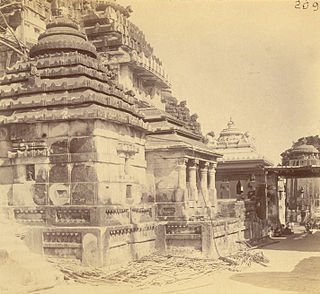
The Vimala Temple or Bimala Temple is a Hindu temple dedicated to goddess Vimala or Bimala (ବିମଳା), located within the Jagannath Temple complex in Puri in the Indian state of Odisha. It is generally regarded as a Shakti Pitha, among the holiest temples dedicated to the Hindu Goddess.

The Chalukya Shiva Temple, dedicated to Shiva, is one of the oldest Hindu temples and is located in the group of monuments at Aihole in the state of Karnataka, India. Formerly dated to the 7th or 8th century, it is now dated to about the 5th century. It is located to the south of the Durga temple, Aihole.
Manwal is a town in Udhampur district of the Jammu division of Jammu and Kashmir, India. It lies 28 km (17 mi) away from the district headquarters of Udhampur.
Rasoi ghara is a traditional kitchen of Jagannatha temple, Puri, Odisha, India. It is the 2nd largest kitchen in the world.

Dibyasingha Deba, known by the symbolic regnal title as Gajapati Maharaja Divyasingha Deva IV is the current titular Gajapati Maharaja and the King of Puri. He is the current head of the house of Bhoi dynasty, who were the hereditary rulers of the ancient realm of Trikalinga, medieval era Khurda Kingdom and the rulers of the Puri Estate, with their current capital located at Puri. The Gajapati Maharaja is the current Adhyasevaka of Lord Jagannatha and according to customs also considered to be the living reflection of the Lord. He is also the chairman of the Shri Jagannatha Temple Managing Committee of the Jagannath Temple at Puri.

Aruna Stambha is a sixteen-sided 34 feet (10 m) tall monolithic chlorite stone Pillar having the idol of Aruna on the top. It is about twenty feet (6.1 m) away from the Singhdwara of Jagannath Temple in Puri.
















